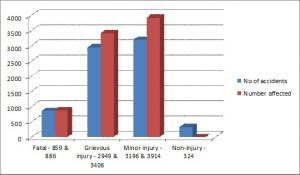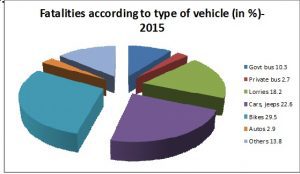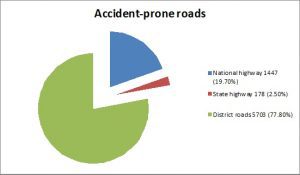67250… 7328….
Are they mere numbers? No, they are the number of people involved in road accidents in Tamil Nadu and Chennai respectively in the year 2015.
With timed traffic lights that are mostly in working condition, police personnel at the signals and an efficient emergency management system, Chennai’s roads appear safe. But statistics tell a different tale. As per NCRB (National Crime Records Bureau) data, Tamil Nadu records the highest number of road accidents; among 53 Indian cities studied, Chennai topped the list, accounting for 11.9% of total road accidents – a fact that the city cannot be proud of.
As per WHO’s (World Health Organisation) Global Status Report on Road Safety 2015, more than 2 lakh people died in India in 2013 in road accidents. In other data released by Save Life Foundation, an NGO working on road safety, India records one death in a road accident every four minutes, which translates to 384 deaths in a day. That is twice the seating capacity of a Boeing 737-800 used by our airlines. In other words, death on the Indian roads in a single day is the same as two plane crashes a day!
Yet, road accidents, their cause and preventive measures are not given due importance either by the administration or by the public. As M Radhakrishnan of Thozhan, an NGO creating awareness on road safety in Chennai, points out very pertinently, “Road accidents. Fatalities. You don’t even think of them, till they happen to you or someone close to you.”
The Ministry of Road Transport & Highways, with the support of National Safety Council, observed Road Safety Week from 11 January to 17 January, 2017. As 2011 – 2020 has been announced as the Decade of Action for Road Safety by WHO (World Health Organisation), the ministry has been observing road safety week every January since 2011, and Chennai has had its share of campaigns. But it is obvious from the statistics that awareness measures advocated over a week are not sufficient.
Injuries – the invisible aftermath of accidents
Newspapers generally report fatal accidents. But accidents result in injuries too – categorised as grievous and minor injuries. Uttam, an engineer in his twenties, suffered grievous injuries and is now confined to the wheelchair after an accident near his workplace in Ambattur.
Loss of hearing, loss of eyesight, fractures, disfigurement of the head or face and any injury that causes the victim to suffer pain and inability to follow his daily routine are classified as grievous injuries. According to statistics from the State Transport Authority, the number of accidents in Chennai causing grievous injuries is three-and-a-half times more than the number of accidents causing death, while for minor injuries, the number is four times as much.
Moreover, there are thousands of minor accidents that go unreported. Vaidehi, an electrical engineer, cites skidding on a road in Nungambakkam over pumpkin smashed to ward off the evil eye. Prabhakar, a marketing executive, cites a bus driver running out of a small roadside temple on Marshalls Road in Egmore and dashing against his bike, and both he and his pillion rider falling in the impact. Parameswaran, a senior citizen, remembers skidding over slush cleared from a manhole near his house in Adyar. There are countless such accidents, resulting in minor injuries. However, none of these made it to the statistics. If they did, the numbers quoted would increase manifold.
Wheel count and accident count
As per reports of the State Transport Authority of the Tamil Nadu government, two wheelers account for nearly 30% of fatal accidents in Chennai.
This fact seems to have a bearing on the decision of some in choosing the vehicle. “Considering my salary, a two-wheeler would be ideal. But I had to buy a car, as my parents feel that riding a two wheeler is unsafe, especially since I commute from Avadi, which is quite far,” says Divya, working in an auditing company in T. Nagar.
But the likes of Divya constitute a small percentage. For, Chennai has 45 lakh registered two-wheelers, which is 95% of the total number of registered vehicles plying the city’s roads. But is the large number of two wheelers the only reason for them being involved in fatal accidents?
The Indian Road Safety & Welfare Trust has pointed out that rash driving, drunken driving and disregarding speed limits and signals by drivers cause a majority of the accidents. According to the State Transport Authority, of the 886 deaths in Chennai in 2015, 881 were due to the fault of the driver. No death was attributed to mechanical defect in vehicles, bad road design or bad weather.
Pedestrians walking and crossing carelessly, disregarding signals and jaywalking tend to cause accidents and are often victims themselves.
Mobile phones seem a recent menace for both pedestrians and drivers. Selvaraj who suffered a fall near Parrys Corner, sheepishly admits that he was talking on his mobile while riding his two-wheeler.
More than 80% of the fatalities recorded in Chennai are men. But of late, even women are seen talking on the phone and manoeuvring the two wheeler with one hand, rues a traffic constable.
In accidents where the vehicle itself is the cause, malfunctioning of brakes and other parts, lack of headlights or blinding headlights of oncoming traffic and wares protruding from trucks are the most common reasons.
Potholes, especially during rainy seasons, also cause many accidents. Pradeep, working in a private construction company, thanks his stars for the miraculous escape a few years back when his two wheeler went into a pothole in a flooded stretch of Poonamallee High Road near Vepery.
Which roads are accident prone?
One would presume that more accidents happen in highways. But statistics reveal that the number of accidents on what are classified as district roads, is higher in Chennai. These are the roads within the Corporation limits, but other than the stretches of National and State Highways.
This shows that the smaller roads and lanes and by-lanes are more accident-prone than the arterial roads.
According to traffic police personnel, however, most of the accidents are preventable. How can they be prevented? The measures that the government and individuals could take to keep Chennai accident-free, and what one should do in case of an accident, will be discussed in the second part of this article.
[Reference: http://www.tn.gov.in/sta/ra4c.pdf]


